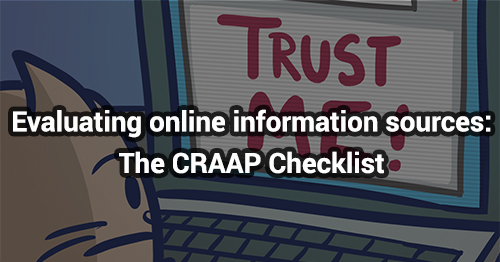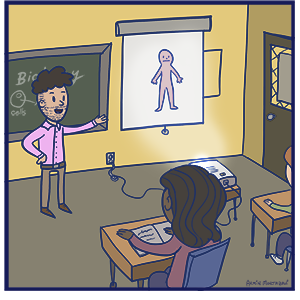Evaluating online information sources: The CRAAP Checklist

It can be hard to know when a story is true or not. This is the case for adults too. We need a reliable way to separate truth from fiction! In the next two lessons, we’ll focus on one way: collecting information.
One effective way to find out if something is true or not is to try to find more information on the topic. However, we still want to make sure that the information we collect is trustworthy. Sometimes even the most basic of facts are up for debate and it's hard to tell the difference between fake and real information. Without good, accurate information, you can’t learn - and worse, you’ll believe in something that is wrong. There are a few ways that you can check if the information you come across is accurate. The CRAAP checklist is one of them.
The CRAAP checklist is an evaluation method that helps you know where and how to find trustworthy information. The CRAAP checklist is called this because each letter stands for something you should look for in reliable information.

The person/site/article that provides information is called a “source”, since they are the “source” of your information. Put another way, the source is where the information was found.
C - Currency
Is the information current? Is it up-to-date?
You should find out when the information was created. This is important because accurate information changes over time. Old information might be out-of-date and not accurate anymore. For example, did you know that we used to think that smoking was good for you? Crazy right? We now know better - but if you came across an old article about smoking, they might say it’s good for you. This is why it’s important to look for up-to-date information.
R - Relevance
Is the information relevant to your topic?
Let’s say you were researching whether smoking is good or bad for your health. If you came across an article about how to reduce the smell of smoke, it might be interesting, but it is not relevant to your topic. Make sure that the information you are looking at helps you answer your question on the topic.
A - Accuracy
Does the information tell the truth?
When you don’t know the topic, it can be hard to know if the information is true. Anyone on the internet can have a site about anything, and can make up fake information. There are a few things that can help you know if what you are reading is fake.
- Look for correct spelling, punctuation, and grammar.
- Good information is written by respected scientists. Respected scientists don’t make many spelling mistakes or grammar mistakes. If you see many mistakes, this is definitely a sign that the site is untrustworthy.
- Look for information that is consistent with other sources
- If you come across a website or article that has completely different information from everyone else, it might indicate that it is untrustworthy. Carefully consider why they disagree with everyone else. What is more likely: that this one person is correct and everyone else is wrong, or that everyone else is right and this one person is wrong?
- See if they have listed their own sources. If they don’t, you should be careful. They might be making things up (by the way, you can see KBI’s sources on our sources page!).
A - Author
Who wrote/recorded/made the information?
The author of an article can often indicate whether the information is good or not. The author can be an organization, a group, or a person. Are they an expert in the field? If not, do they cite (ask, quote, or listen to) experts in that field? You want to make sure that the people writing the article (or making the video, or podcast etc) know what they are talking about.
P - Purpose
Why was this information created?
It’s important to consider why a piece of information exists. Did they create the article to sell you something? Are they trying to convince you to do something?
(Part 2) - How to Collect Trustworthy Information: Primary & Secondary Sources

Primary and Secondary Sources
Whenever we do research, it’s important to use the right sources to gather our information. A source can be anything we use to learn about a topic, from a news article online, a photograph, or even a conversation with someone. Understanding our sources can help us to avoid making mistakes in what we’re writing and to learn more about the topic. People often talk about two types of sources: primary sources and secondary sources. So, what are they and what’s the difference?

Primary Sources
Primary sources provide first-hand evidence about the topic you are researching. If you are researching an historical event, primary sources are those that were created by people who were actually there, for example photographs of the event or a news article written by a journalist at the time. It’s the same if you are researching a person. A primary source about a person could be a photograph or video of them, or something they have written like a letter or journal. Let’s say you’re writing an essay about the scientist Marie Curie, who discovered radioactivity. You could use lots of primary sources about her, like photographs, letters she wrote, or some of her essays. You could even go to a museum and see real things she used, like laboratory equipment.
Researchers like to use as many primary sources as they can because they are closer to the people or events being investigated. The more primary source material you have, the easier it is to understand what really happened.

Secondary Sources
Secondary sources are important too, but they are a bit different. A secondary source is something that describes or interprets information found in primary sources. For your research on Marie Curie, you will probably go to the library to find books about her. The authors might talk about the impact of her discoveries or how she won the Nobel Prize (twice!). These are secondary sources because they rely on the writer’s interpretation of the facts to tell us a story about her life and work.
Documentaries are another good type of secondary source. They often use pieces of primary source footage, but then present it in a way that creates a story. Documentaries usually have someone speaking over the video to explain what we see and help us interpret it. That helps us understand more about what we are seeing, but it means the documentary is a step removed from what actually happened.

Why is this so important?
Imagine your friend comes to class one day and claims to have seen a rainbow on the way to school. Your friend is a primary source because they witnessed the rainbow. Now, if you tell another friend about it at lunch time, you are a secondary source because you didn’t see the rainbow yourself, you only passed on what you heard from your other friend. You can’t describe how bright it was or if there was a pot of gold at the end, because you weren’t there to see it. This is why researchers like to use primary sources: you’re more likely to get accurate information from the person who saw the rainbow than from someone who only heard about it second-hand.
So, next time you learn something or hear a story, ask yourself, is this a primary source (first-hand evidence) or a secondary source (someone’s interpretation of the evidence)? Understanding the difference between primary and secondary sources can help us think critically about the things we learn, making us all better researchers!
All lessons & quizzes are free!
This was just one of the lessons in our Critical Thinking section. There are over 60 lessons on Kids Boost Immunity just like this one on a variety of subjects. Each lesson includes a quiz, and every time a student scores 80% or higher on a quiz, we will donate life-saving vaccines to UNICEF Canada. Sign up now!



